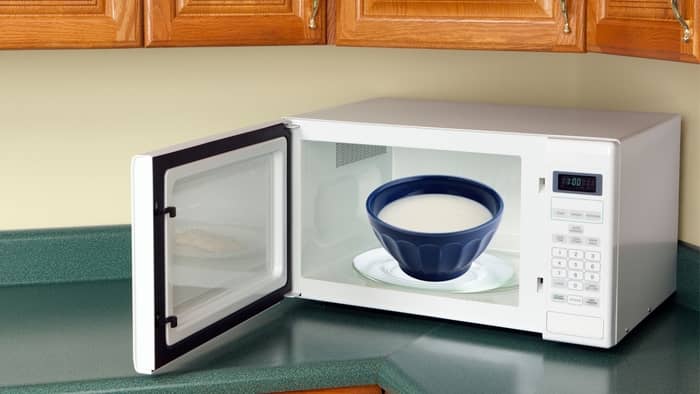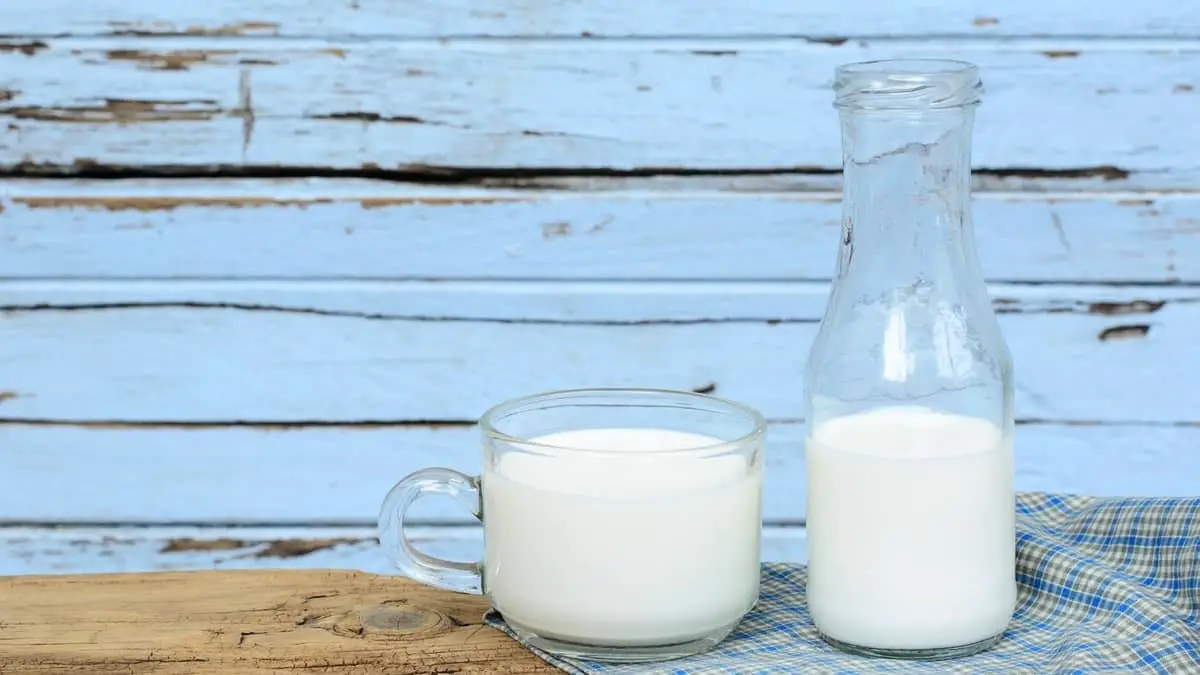Last Updated on February 12, 2023
Wondering how to bring milk to room temperature? Cake recipes require room-temped dairy, and it is crucial. Because when you beat milk at room temperature using an electric mixer, it creates an emulsion that traps air. For that reason, the trapped air expands inside the oven, producing a fluffy consistency, and without this process, your baked goods would become flat and very dense.
Moreover, keep in mind that you can beat cold milk, and it would still trap air; however, it would not be sufficient to make light, fluffy cakes, and tender cookies.
In comparison, ingredients like milk would blend better at room temperature and create a smooth, thoroughly blended batter that will make a uniform texture and even bake.
Generally, you should never leave your milk or dairy out of the refrigerator for longer than two hours. To bring it to room temperature safely and quickly, you need to pour it inside a microwave-safe bowl and heat it inside the microwave for about a few seconds.
Also, heat a half cup of milk inside the microwave for about twenty seconds. For a cup of milk, microwave for thirty seconds, and for two cups of milk microwave for about forty-five seconds.
Next, stir the milk as the microwave does not heat your milk evenly. Then, to feel the temperature, put your finger in the milk. If your milk feels colder than room temperature, you can continue to reheat your milk in ten seconds, stirring and feeling its temperature after each time.

How to Bring Milk to Room Temperature?
How long does it take for milk to come to room temperature? In most cases, the time for your milk to reach room temperature depends on the amount of milk you need. If you ever leave your milk at the counter, it will probably take forty minutes for a cup of milk to reach room temperature. But, you can use several methods to bring your milk to room temperature.
First is the use of the microwave. With this, start by measuring your milk by placing it inside a cup or microwave-safe bowl. Then, be sure to microwave it at ten-second intervals. Afterward, stir after each time and measure the temperature of your milk. Once it reaches twenty-two degrees Celsius or seventy-two degrees Fahrenheit, it means you have reached room temperature.
Moreover, the second method is by measuring your liquid and placing it inside a bowl or a measuring cup. Then, make sure to put it into your large mixing bowl. Next, carefully pour hot tap water into the large bowl. This method will take about five to ten minutes, depending on how much milk you have. Also, warming your milk in a shallow container will increase the surface area and quickly bring it to room temperature.
Importance of Room-Temped Milk
Should milk be at room temperature for baking? Yes, precision is indeed crucial when it comes to baking. Also, it does not only refer to how you measure your flour and other ingredients. In general, preparing your ingredients is also essential.
The ingredients’ temperature is also crucial to create the best results; remember that ingredient temperature plays a significant role in developing the proper structure in most baked goods. For that reason, when milk and other ingredients are at room temperature, it creates an emulsion that traps air. And when baked inside the oven, that trapped air expands, resulting in fluffy baked goods.
Toshiba EM925A5A-SS Microwave Oven with Sound On/Off ECO Mode and LED Lighting
Additionally, room-temperature ingredients like milk bind together with other ingredients easily when warm, creating an even textured batter. And when you have a smooth batter, it equates to uniformly textured goodies.
Besides, when you use cold milk when baking, the fat in the milk solidifies and turns into tiny chunks. So, to stop your cake batter from breaking, bring all of your ingredients to the same temperature to emulsify them effortlessly together. That is why milk should be at room temperature when baking.
Moreover, how to bring milk to room temperature faster? Again, milk and other baking ingredients need to be at room temperature for baking because it will help your batter and dough come together. Plus, it will undoubtedly blend wonderfully.
Consequently, whenever you use cold ingredients, your batter can become lumpy and curdled; bear in mind that room-temped ingredients can quickly emulsify and mix, resulting in silky batters and smooth doughs.
So, how can you bring your milk to room temperature faster? The answer is easy, and that is to use a microwave. Leaving dairy products like milk at room temperature for more than two hours is not advisable and safe.
To bring your milk to room temperature, microwave a cup of milk on a high setting for about thirty seconds and half a cup of milk for about twenty seconds.
Next, gently stir to even out the temperature. It does not require you to overheat your milk, as you only need to take the chill off. Also, when using room-temped dairy products like milk, avoid letting them sit for long periods as it can allow bacteria to flourish. So with that, use them as quickly as possible.
Bringing Refrigerated Breast Milk to Room Temperature
How to bring refrigerated breast milk to room temperature? Mothers’ breast milk provides your baby with many benefits, and even when you cannot feed your babies with breast milk from your breasts, you can give it to them through a milk bottle.
In that regard, giving your babies breastmilk that is too cold and too warm may not be appealing to your babies. Even when it is difficult to judge the correct temperature of your breast milk, you can bring the breast milk as close to room temperature as possible before giving it to your babies.
To do so, first, remove your frozen breast milk from the freezer. After that, place it inside the refrigerator for about twenty-four hours to thaw. Next, place the container of your cold breast milk inside a bowl with warm water. Then, be sure to allow it to sit in the warm water for about ten minutes.
Finally, check the breast milk’s temperature by placing a few drops on your wrist. If the milk is still cold, replace your warm water inside the bowl and let it soak for another minute or more until it has reached room temperature.
If you are rushing and need to quickly thaw your frozen breast milk, run it under cool water, then run it with warm water until the milk thaws. Once the milk has softened, allow it to reach room temperature by placing it inside a bowl with warm water. Also, remember that once you have thawed your frozen breast milk, use it within twenty-four hours, and do not freeze it again.
How Long Does it Take for Milk to Get to Room Temperature?
If you’re wondering about the time it takes for milk to come to room temperature, there is no definitive answer. It all depends on the environment and the humidity. Typically, it’ll take around 20-30 minutes to come to the temperature you need for baking.
Should Milk be at Room Temperature When Baking?
Yes. If you’re looking for fluffy baked goods, such as cakes, frosting, and cheesecakes, you should bring the following ingredients to room temperature before using them in your recipes:
- cream cheese
- butter
- buttermilk
- milk
- cream
- milk
- eggs
How to Make Milk Room Temperature Fast
To make milk come to room temperature as fast as possible, you simply need to add it to a heat-proof bowl and heat it in 10-second intervals until it reaches the level of heat you’re looking for. It’s important to only have your microwave at 20% power when doing this so that your milk doesn’t curdle.
How to Bring Other Baking Ingredients to Room Temperature
As well as milk, you should bring many other ingredients to room temperature when baking. Let’s take a look at how to do this effectively, for each baking ingredient.
- Butter. Simply remove your butter from the fridge and leave for around 30-60 minutes to soften. After this point, it should be at room temperature. You can cut your butter into cubes, columns, or any other shape, to quicken the softening of the butter. If you still need the process to be quicker, add to a heat-proof bowl and heat in 10-second increments at just 20% power. The temperature of the butter should be between 65-70F, for best results.
- Eggs. Eggs are one of the easiest ingredients to bring to room temperature. Simply fill a bowl with warm water (just warm water, it shouldn’t be hot). Add the eggs to your bowl, and leave them for around 5-10 minutes. Remove from water, and use as needed.
- Buttermilk and Cream. Bringing these ingredients to room temperature is very similar to bringing milk to room temperature. Pour the ingredient into a heat-proof bowl and heat in your microwave for 10 seconds at a time. Your microwave should only be at 20% power, for best results. You can also do it in a saucepan over low heat if you’d prefer. It’s important to only bring it to room temperature though, not warm.
- Yogurt and Sour Cream. You mustn’t place yogurt or sour cream in the microwave, as it’s likely to affect the odor and taste of the product. You can try removing from it’s container and placing it in a warm area of your house. But I’ve found it’s best to leave these ingredients to come to room temperature naturally. This should take anywhere from half an hour, to an hour.
Conclusion
I hope this post has helped you to become more familiar with how to bring milk to room temperature; as well as how to bring other baking ingredients to room temperature quickly and effectively. Do you have any tips and tricks when it comes to room-temperature baking ingredients? If so, please feel free to let me know in the comments below. Sharing is caring!
FAQs
How Long Does It Take For Milk To Come To Room Temperature?
In general, the time it takes for your milk to reach room temperature relies on the milk's quantity. For instance, leaving a cup of milk at the counter will take about forty minutes to attain room temperature.
Should Milk Be At Room Temperature For Baking?
The answer is yes. The main reason is that ingredient temperature plays a vital role in creating the appropriate structure in most baked goods. Besides, when your milk is at room temperature, it will undoubtedly make an emulsion that traps air. Because of that, the trapped air indeed expands when baked inside the oven. As a result, it produces incredibly light and fluffy baked goods.
How To Bring Refrigerated Breast Milk To Room Temperature?
Before anything else, be sure to remove the frozen breast milk from your freezer. Then, make sure to put it inside your fridge; do so for approximately twenty-four hours so it can thaw. Afterward, place the container of the cold breast milk inside your bowl with warm water. After that, make sure to let it sit in warm water for around ten minutes. Lastly, be sure to check the temperature of the breast milk; you can do so by pouring a few drops on your wrist.
How To Bring Milk To Room Temperature Faster?
Well, you can do so using a microwave. Start by microwaving a cup of milk on a high setting; do so for about thirty seconds. Likewise, only do it for about twenty seconds for a half cup of milk. Afterward, stir them to even out the temperature; remember that it is unnecessary to overheat the milk. The reason is that you only need to take the chill off.

Zarah is an experienced pastry chef whose creations have delighted countless customers. With a passion for baking, Zarah has developed a unique style that combines classic techniques with modern flavors. Her desserts are consistently crafted with the finest ingredients, and her attention to detail is evident in the stunning and delectable results. Zarah has a wealth of experience in the pastry kitchen, and loves to share her knowledge with others. Whether it is teaching a class or creating a custom cake for a special occasion, Zarah is committed to making sure every customer is satisfied.


